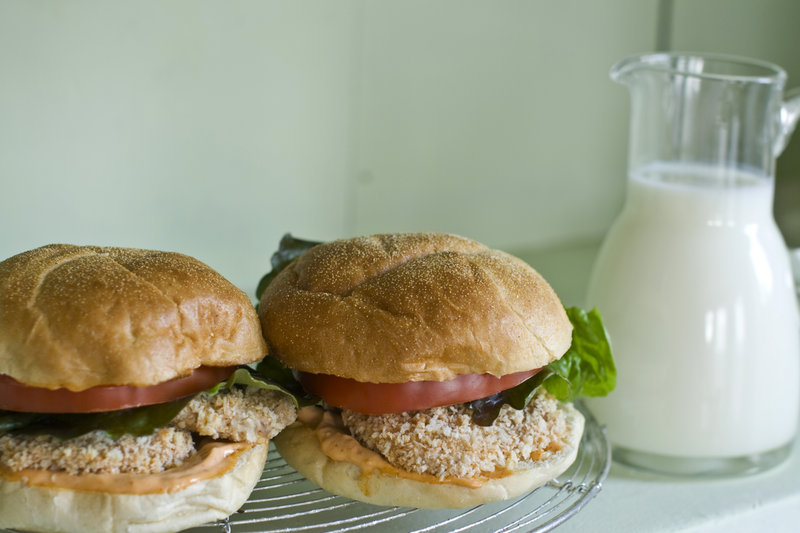The problem with buttermilk is there isn’t a lot of “real” buttermilk around.
The good news is that the newfangled buttermilk available at most grocers isn’t all that bad. Better yet, it’s easy to make the real stuff yourself.
But first, a buttermilk primer. As its name suggests, buttermilk is the tangy milk-like liquid left behind when cultured cream is churned to make butter. At least that’s how they made it in the old days. Today, it’s usually commercially produce by adding cultures (think the bacteria that produces yogurt) to low- or no-fat milk.
Either way, you end up with an acidic, thick, milky liquid. But why is this considered an ingredient that’s off the beaten aisle? After all, we’ve all had buttermilk pancakes and waffles. It’s because what most people don’t realize is just how versatile an ingredient buttermilk is. And it belongs on the dinner table as much as at breakfast.
Let’s start with buttermilk’s signature tang. It’s tangy because it’s acidic, and acidic ingredients make for great marinades. Give chicken, pork or turkey a buttermilk bath and you’ll get especially tender, flavorful meat. Before you add the meat, just whisk in whatever seasonings you want.
And that same tang turns out killer mashed potatoes. Use it in place of regular milk, then mash away. Ditto for sweet potatoes.
Next time you’re making vinaigrette for your salad or roasted vegetables, add buttermilk for rich, luxurious flavor. Try a blend of olive oil, buttermilk, lemon juice, strawberry jam, salt and black pepper.
Buttermilk also is delicious in fruit smoothies. Substitute buttermilk for a quarter to half of the liquid you’d normally use.
When shopping for buttermilk, most of what you find at the grocer is labeled “cultured buttermilk,” which generally refers to low-fat or skim milk that has been cultured. But a number of regional dairies now sell “real” buttermilk, a smart use of the liquid leftover from their butter making operations.
But it’s also easy enough to make your own. And the best part is that in the process, you also get some delicious homemade butter (the very best there is). Just purchase a pint of the very best quality heavy cream you can find. Place it in a food processor and process for several minutes.
The cream will get thick and resemble whipped cream. Continue processing until the whipped cream breaks and the fat solids come together as butter. At this point there should be one or two large clumps of butter and a fair amount of milky liquid in the processor. Pour off the liquid — this is your buttermilk. Season the butter with salt, then use or refrigerate. It’s that simple.
BUTTERMILK-SOAKED PORK CUTLET SANDWICHES
Start to finish: 20 minutes, plus marinating
Servings: 4
1-pound pork tenderloin
1 cup buttermilk
1 tablespoon plus 1 teaspoon Thai red curry paste, divided
1 teaspoon kosher salt
2 cups panko breadcrumbs
1/2 teaspoon ground black pepper
1/4 cup mayonnaise
1/2 teaspoon cider vinegar
4 burger rolls
Boston or other leafy lettuce
1 large tomato, sliced
Cut the tenderloin crosswise into thin rounds, each about 1/4 inch thick. One at a time, set each round between sheets of plastic wrap and pound evenly thin using a meat mallet or rolling pin.
In medium bowl, whisk together the buttermilk, 1 tablespoon of the red curry paste and salt. Add the pork and ensure it is evenly covered by the liquid. Refrigerate for at least 1 hour and up to 8 hours.
When ready to cook, heat the oven to 400F. Coat a baking sheet with cooking spray.
In a wide, shallow bowl, mix the breadcrumbs and pepper. Remove the pork cutlets from the marinade. Dredge each piece through the breadcrumbs, patting them on as needed to coat evenly. Arrange the pork cutlets on the prepared baking sheet.
Bake for 10 minutes, or until lightly browned and cooked through.
Meanwhile, in a small bowl, whisk together the remaining 1 teaspoon of red curry paste, the mayonnaise and vinegar. Slather a quarter of the mixture over the bottom half of each burger roll. Top with lettuce and tomato, then 1 or 2 pork cutlets. Serve immediately.
Nutrition information per serving (values are rounded to the nearest whole number): 450 calories; 100 calories from fat (22 percent of total calories); 11 g fat (3 g saturated; 0 g trans fats); 80 mg cholesterol; 54 g carbohydrate; 34 g protein; 2 g fiber; 990 mg sodium.
J.M. Hirsch is the national food editor for The Associated Press. Follow him on Twitter at http://twitter.com/JM-Hirsch.
Send questions/comments to the editors.



Success. Please wait for the page to reload. If the page does not reload within 5 seconds, please refresh the page.
Enter your email and password to access comments.
Hi, to comment on stories you must . This profile is in addition to your subscription and website login.
Already have a commenting profile? .
Invalid username/password.
Please check your email to confirm and complete your registration.
Only subscribers are eligible to post comments. Please subscribe or login first for digital access. Here’s why.
Use the form below to reset your password. When you've submitted your account email, we will send an email with a reset code.